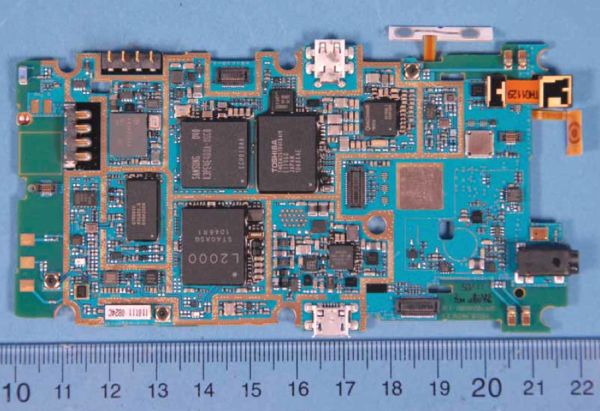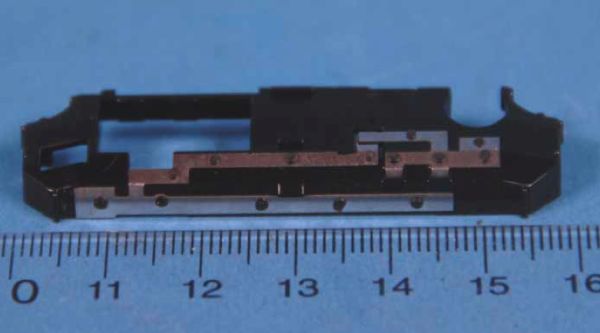LG Revolution: LTE for the Masses
by Vivek Gowri & Brian Klug on June 21, 2011 5:55 AM EST- Posted in
- Smartphones
- Verizon
- LTE
- Mobile
- LG Revolution
We've talked about the cellular architecture of the HTC Thunderbolt and Verizon's 4G LTE network in general, we're going to talk about the Droid Charge's and it's time now to talk about the LG Revolution's. Each phone is a bit different, but both differ significantly from the HTC Thunderbolt in that they don't offer the ability to simultaneously transact data and maintain a voice call.
For a quick refresher, the HTC Thunderbolt is based on a combination of the cellular baseband from Qualcomm's MSM8655 SoC, and MDM9600. The MSM8655 maintains 1xRTT for call processing, the MDM9600 handles both EVDO and LTE data. Things are different with both the LG Revolution and Droid Charge.
The LG Revolution (as we've already mentioned) is based on Qualcomm's MSM8655 SoC. However, in this configuration, the part handles all 3GPP2 connectivity - that means 1xRTT for voice and slow data, and EVDO for faster 3G data. 4G LTE connectivity is supplied using LG's own cellular baseband, the L2000. L2000 is also used in LG's 4G LTE modem dongle, the VL600. The combination of MSM8655 and L2000 means that the LG Revolution supports simultaneous voice and data only when connected to 4G LTE.
There's not much to say about the L2000 quite honestly. Like both the Samsung CMC220 in the Droid Charge and the Qualcomm MDM9600 in the Thunderbolt, it is a category 3 modem, meaning it supports the exact same maximum throughput rates and should offer very similar performance. All three modems are only provisioned and certified for Verizon's LTE band 13 in each handset as well. Again same as the Thunderbolt, the LG Revolution has two Rx antennas for Rx diversity, and one Tx antenna.
Verizon famously showed off the LG Revolution on stage doing a voice call over Verizon 4G LTE. Unfortunately that functionality is disabled in this final version, as it is on every 4G LTE device we've tested. It's in the FCC certification documents, and without an amendment will likely remain off until the next 3GPP release when voice comes back around.
The interesting thing about the LG Revolution is that it actually already has been through the FCC once, then went through a second time for a class 2 change. This change added power reduction management for supporting simultaneous voice, LTE data, and WiFi modes. Anytime the hotspot is active, power reduction is applied to either voice or the LTE data session until the hotspot is deactivated. Like we discussed with the Thunderbolt, these changes were put in place to prevent the handset from exceeding SAR requirements. The interesting additional note is that the LG Revolution appears to have undergone a slight board rework and received a different antenna between FCC visits. Either way, the final shipping device properly implements all the requisite power reduction schemes for simultaneous operation of all the relevant radios.

As we'll show shortly, the L2000 seems to be pretty light on power consumption, putting the LG Revolution at the front of the pack in our battery life suite. Vivek did his testing in the Seattle, WA area, while all of my testing has so far been done in Phoenix, AZ or Newport, CA, but at this stage in the game every Verizon 4G LTE market is running on the same 10 MHz FDD of LTE Band 13, and we've been careful to keep receive power about the same. Remember again that the only part of the LTE cellular architecture that has a power control loop is from handset to tower, and our tests consist of loading many webpages, which ends up consisting of much more data heading from the tower to the handset than the other way around.
Regardless, the important takeaway is that we're confident we have comparable battery life numbers, and interestingly enough the LG Revolution comes out on top. That said, the difference ends up being a whole 40 minutes, plus or minus our margin of error. If you're looking for super long battery life, basically none of the 4G LTE phones are going to cut it right now.
The LG Revolution allows one to force 1x/EVDO, or 1x/EVDO + LTE, but not manually force LTE-only data connectivity plus 1x voice. The former gets you better battery life by only using the baseband on the MSM8655, the latter gets you 4G LTE in addition by using L2000. You can decide to make that tradeoff however.











24 Comments
View All Comments
antef - Tuesday, June 21, 2011 - link
I believe even streaming video will not make use of anything > 5 Mbps or even less. HD Netflix on a PC only requires about 5-6 and I don't think you're getting that same 1080 resolution from the Netflix app on the phone. So I really don't see what good > 5 Mbps is on a phone unless you're tethering to a computer and doing downloads on that.name99 - Wednesday, June 22, 2011 - link
I don't want to be cruel but, good god, you are stupid.What these devices enable is
(a) substantially more CONSISTENT performance across a cell. Instead of the maddening variability of the current system, you should, much more often, get decent performance even at the edge of a cell.
Unfortunately, the one place you'd most like to have this is with voice, and it seems that our oh-so-sophisticated cellular overloads can't get their act together enough to move their voice transmission onto 21st century technology. Perhaps if we're lucky, this will happen sometime before 2025.
(b) somewhat better usage of the limited bandwidth available (ie a larger aggregate bandwidth for the entire cell), which in turn means that in places where, right now, data can be so slow as to be useless, data will now perform somewhat better.
Once again, this likewise has implications for voice meaning, for example, that (once the cell companies get their act together) there will be less need to drop to the low bit rate (and really crappy sounding) codecs.
One can understand why the cell companies talk up 4G speeds. The numbers are easily understood as meaning "better than now", and discussing them does not mean having to concede "yes, our current systems are inconsistent, frequently overloaded, and have crappy voice".
There is rather less justification for why ARS obsesses about these peak speeds, rather than discussing the actual issues that 4G technologies improve --- aggregate bandwidth and signal consistency.
Omega215D - Tuesday, June 21, 2011 - link
I have a stock Thunderbolt and I see better battery life than what's indicated here and I live in NYC. Moderate usage gives me 18 hours of life while constant internet pegging brings me down to 5 - 7 hours all on LTE. I've never experienced intermittent LTE signals when here or traveling (to other LTE cities) either.LTE makes sense for quick pull ups of sites when on the road, like restuarants/ eateries, or for my future plans of video calling my friends who are moving overseas while I make my move to the west coast.
Also I am grandfathered into Unlimited Data in which I am happy that I got my T-bolt when I did.
PCTC2 - Tuesday, June 21, 2011 - link
Just letting you know there's a typo. Nothing big."Brian saw LTE speeds clustered around 10 Mbps down and 2-3 Mbps down."
Isn't the second one supposed to say "up"?
As for 4G, I would appreciate the speed even remotely close as I barely get 1 Mbps down, 0.2 Mbps up, but I guess I can't complain because 80% of my day is spent in WiFi coverage anyways.
VivekGowri - Tuesday, June 21, 2011 - link
Fiiiiiixed :)Lolimaster - Tuesday, June 21, 2011 - link
Now Anand, remove sysmark from your cpu benchmark, it's now a useless biased bench. We all know that except "some" sites.http://semiaccurate.com/2011/06/20/nvidia-amd-and-...
bluelite - Tuesday, June 21, 2011 - link
Wait. Isn't this the same engine as the one on my over year old Incredible ? And LTE is nice. IF it is available at your location. It's not available here. Suffolk County Long Island.Omid.M - Tuesday, June 21, 2011 - link
I picked up a used Thunderbolt for $330. That included shipping, 5 batteries, two chargers, case & holster, and screen protector.Why did I do this? I dislike the phone itself but this was the fastest way to secure unlimited 4G before tiered plans come (likely early July). I will use the Bolt until a phone based on Krait comes to market. I hope HTC releases something like the Sensation for Verizon, based on Krait and with a qHD/SLCD display. I want the Galaxy S2 but I doubt it'll have LTE. There's just no way.
Yes, I would buy my next phone off contract to avoid locking myself into a contract with new terms (i.e. tiered data plans).
Mr Perfect - Tuesday, June 21, 2011 - link
Could you test out the camera's macro mode? One of the main things I use my phone's camera for is taking pictures of small parts and labels, things like product and serial numbers, connectors and those little bits that people always manage to break off of devices. My current phone is OK at best, usually requiring some trial and error with things like distance, flash and focus. Thanks!Impulses - Tuesday, June 21, 2011 - link
"this is a huge peeve of mine with the HD7, iPod touch, and anything Samsung makes - bottom-mounted headphone jacks and side-located power buttons are stupid."Wow, I strongly disagree on both counts... I know a lot of people prefer the top mounted headphone jack because it's easier to hold the device this way with headphones plugged in, but I generally listen to music with the phone in my pocket... I also tend to slip it into my pocket upside down so that when I slide my palm over it and take it out the device is already right side up. However that's impossible to do with headphones plugged into a top mounted jack, unless the headphones have an L plug (and even then it's awkward).
It might be a different story for people with thinner phones or pockets (i guess they'd pinch the screen or the sides to slide it out, which always felt precarious with my EVO)... It's a pretty personal thing I guess.
The side power button isn't as personal a matter tho, imo. I've got fairly long fingers and after a year with an EVO I don't see why anyone prefers it up top on any 4.3"phone, no matter how you hold the phone it requires an awkward finger reach to press... Samsung's side mounted lock button seems like the way to go imo. Even better would be a front button that wakes up the device, I like capacitive buttons better but I do miss the ability to easily wake it while it's laying down (without gripping it to press a side button).
Surely there's gotta be an ingenious solution that combines all the pro's and con's... At least most Android devices are coming with notification lights.